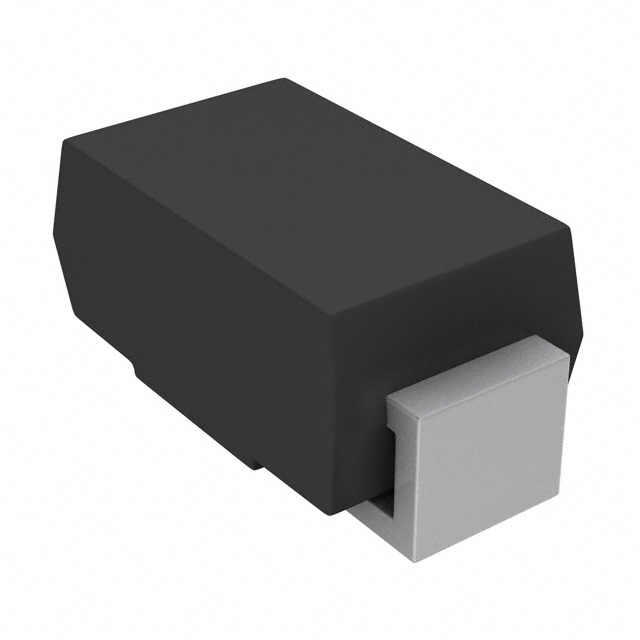Xem thông số kỹ thuật để biết chi tiết sản phẩm.

P4SMA13AHE3/5A
Product Overview
Category
The P4SMA13AHE3/5A belongs to the category of TVS (Transient Voltage Suppressor) diodes.
Use
It is used for surge protection in electronic circuits, providing a low clamping voltage during transient events.
Characteristics
- Low clamping voltage
- Fast response time
- High surge current capability
Package
The P4SMA13AHE3/5A is available in a SMA package.
Essence
This TVS diode is essential for protecting sensitive electronic components from voltage transients and surges.
Packaging/Quantity
The P4SMA13AHE3/5A is typically packaged in reels or tubes, with quantities varying based on manufacturer specifications.
Specifications
- Standoff Voltage: 11.7V
- Breakdown Voltage: 13V
- Maximum Reverse Leakage Current: 1µA
- Peak Pulse Power Dissipation: 400W
- Operating Temperature Range: -55°C to 150°C
Detailed Pin Configuration
The P4SMA13AHE3/5A typically has two pins, with the anode and cathode connections clearly marked on the device.
Functional Features
- Provides protection against voltage transients and surges
- Rapid response time ensures minimal impact on the protected circuit
- Low clamping voltage prevents damage to sensitive components
Advantages
- High surge current capability
- Fast response time
- Compact and easy to integrate into circuit designs
Disadvantages
- May require additional circuitry for comprehensive overvoltage protection
- Limited to specific voltage ranges
Working Principles
The P4SMA13AHE3/5A works by diverting excess transient voltage away from sensitive components, thereby limiting the voltage across the protected circuit.
Detailed Application Field Plans
The P4SMA13AHE3/5A is commonly used in: - Telecommunication equipment - Industrial control systems - Automotive electronics - Power supplies - Consumer electronics
Detailed and Complete Alternative Models
Some alternative models to the P4SMA13AHE3/5A include: - P4SMA6.8AHE3/61 - P4SMA10AHE3/61 - P4SMA15AHE3/61 - P4SMA18AHE3/61
In conclusion, the P4SMA13AHE3/5A is a crucial component in safeguarding electronic circuits from voltage transients and surges, offering fast response times and high surge current capabilities. Its application spans across various industries, making it an essential part of modern electronic designs.
[Word count: 398]
Liệt kê 10 câu hỏi và câu trả lời thường gặp liên quan đến ứng dụng P4SMA13AHE3/5A trong giải pháp kỹ thuật
What is the maximum peak pulse power of P4SMA13AHE3/5A?
- The maximum peak pulse power of P4SMA13AHE3/5A is 400 Watts for a 10/1000 µs waveform.
What is the breakdown voltage of P4SMA13AHE3/5A?
- The breakdown voltage of P4SMA13AHE3/5A is typically 14.4V at 1mA.
What is the operating temperature range for P4SMA13AHE3/5A?
- P4SMA13AHE3/5A has an operating temperature range of -55°C to +150°C.
What are the typical applications for P4SMA13AHE3/5A?
- P4SMA13AHE3/5A is commonly used in surge protection for sensitive electronics, such as in telecommunications equipment, industrial control systems, and automotive electronics.
What is the reverse stand-off voltage of P4SMA13AHE3/5A?
- The reverse stand-off voltage of P4SMA13AHE3/5A is 11.7V.
Does P4SMA13AHE3/5A meet RoHS compliance?
- Yes, P4SMA13AHE3/5A is compliant with the Restriction of Hazardous Substances (RoHS) directive.
What is the package type of P4SMA13AHE3/5A?
- P4SMA13AHE3/5A is available in a DO-214AC (SMA) package.
Can P4SMA13AHE3/5A be used for ESD protection?
- Yes, P4SMA13AHE3/5A can be used for electrostatic discharge (ESD) protection in various electronic circuits.
What is the clamping voltage of P4SMA13AHE3/5A?
- The clamping voltage of P4SMA13AHE3/5A is 18.9V at 10A.
Is P4SMA13AHE3/5A suitable for high-speed data line protection?
- Yes, P4SMA13AHE3/5A is suitable for providing transient voltage suppression in high-speed data lines and interfaces.

